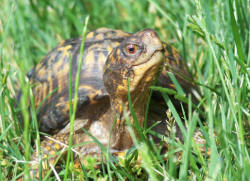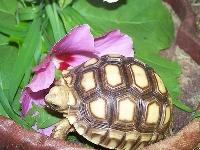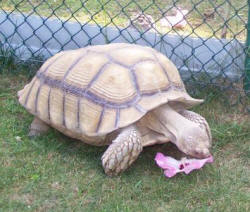|
| Home
Important information Shipping Turtles
|
SULCATA
TORTOISE
Sulcata tortoises, -Centrochelys
or Geochelone Sulcata,
also referred to as the African spurred tortoise, is the third largest
tortoise in the world. Originating in the sub-Saharan regions of
Africa where they once covered a vast range, they began being imported
into the pet trade and now only isolated groups are found where this
magnificent tortoise once roamed in abundance. They are no longer
imported into the United States and are protected under CITES *
regulations. It is amazing to me how a tortoise is now in need of
protection in itís native country when here in the states we are
begging people to stop breeding them: there are so many ending up in
rescues because of the irresponsible breeding and selling of them. So
many saw how easy it was to make a quick buck and jumped on that
opportunity. Sad that so many Sulcata tortoises have had to pay the
price for that selfish act.
Each year we at Turtle Rescue
of Long Island take in many turtles and tortoises that need to be
placed in new homes for one reason or another, but by far the
Sulcataís take the lead on those that come in here in the worst
shape for reasons of poor husbandry and the excuse is almost
always ďThe tortoise is getting too big.Ē Letís face it, where in a
colder climate are you going to keep a tortoise that is going to
grow to weigh over a hundred pounds? No Sulcata or any tortoise
should ever live in a tank, but thatís where most start out. Pet stores
sell them with that cute little ten gallon tank. That poor thing then
gets roasted for the first year of itís life because some uneducated
pet store employee told the new tortoise keeper this is a desert
tortoise and it can live in here on sand and will get itís water from
the lettuce you feed it. WRONG! They then throw a heat lamp over that
tank and literally dry out that poor tortoise and by dehydrating it
cause the shell to start to deform. Then MBD (Metabolic Bone Disease)
begins. The tortoise is usually fed romaine. Letís take a look at
the nutritional value of romaine compared to a couple of more favored
greens.
| Unit | Romaine | Turnip Greens | Dandelion Greens |
| Water g | 94.61 | 89.67 | 89.80 |
| Fiber g | 2.1 | 3.2 | 2.9 |
| Calcium mg | 33 | 190 | 140 |
| Phos. mg | 30 | 42 | 42 |
| Vit. A IU | 8710 | 11587 | 14544 |
Source: http://www.nal.usda.gov/fnic/
In the wild these tortoises
survive on grasses and weeds. They need a high-fiber low-protein
diet: one should always look for a double calcium-to-phosphorus
ratio when feeding greens. If you look at the difference between the
romaine and the other two greens above youíll see the turnip greens and
dandelion greens are a much better choice by far to add to the diet
than romaine. Ideally the tortoises should be outside grazing and
grass and weeds should comprise 70% of their diet, with 30% being the
dark leafy greens. If a Sulcata must be kept inside and grass is not
available then a diet more like the natural diet it would receive in
the wild should be provided. In the wild they will find dry grasses and
have even been seen pushing clumps of grasses into their chambers in
the wild to live off of during the harsh months when no food is
available. Here we can provide them with hay, which would be the same
thing. Orchard grass, timothy, hay salad, botanical blends, can be
given, just not alfalfa which is high in proteins. The hay salad
available from www.carolinapetsupply.com is a great addition to some greens
for a tortoise that does not have access to outside grazing.
Iíve occasionally heard
hatchling tortoises should only be fed greens. Phooey! If they were in
the wild and they were left to fend for themselves they would be eating
whatever the adults were eating. Itís a cruel world out there and once
those babies hatch in nature they fend for themselves. They donít have
us tortoise keepers hovering over them cutting their greens and making
sure their food is soft. Personally I donít think we are doing them any
favors by doing so. By adding hay salad to their food at an early age
they are being fed a good diet and getting used to eating the right
foods from the get-go. Every Sulcata tortoise, young and old, that
comes through our rescue gets fed the same diet. In the summer they get
to graze on the grass, clover, broadleaf weeds and various plants that
we have that are edible (none chemically treated) but in addition to
that they get fed a couple of times a week a mix of hay salad with dark
leafy greens so they are used to the texture and taste of the hay. I do
this so if they go on to live in a home where they need to be fed hay
they are used to eating it. Not everyone has access to an outdoor
grazing area twelve months out of the year and with our current
temperature trends most keepers in all states have at least a few weeks
time during which they have to bring their Sulcata in and feed them. It
helps to get them used to eating hay at an early age. If the tortoise
is really small I take the hay salad and put it in a blender to make it
even finer adding it to dampened greens. It sticks to the wet greens so
they get it that way including the flavor.
Diet is just one of the
important factors when keeping a Sulcata tortoise but itís not the only
thing to keep in mind when you have one of these tortoises in your
care. In the wild although they come from an arid region they also have
a rainy season so they are not always as dry as one is led to believe.
It has also been found that when in their burrows the humidity can
quite high. This is likely due to their expelling urates while in these
burrows. One of the biggest mistakes new Sulcata keepers make is to
keep their tortoises too dry. They stick them in a tank on desert sand
with no water. BIG MISTAKE! Add the basking light and this is slow
death for a tortoise. They actually dehydrate very quickly. The habitat
should have a substrate that is slightly damp. Not moist, not wet, just
slightly damp. Just damp enough that when you squeeze a clump of it the
clump will hold together but no water drips out. A great substrate is
an equal mix of coir and play sand. Coir is shredded coconut fiber sold
in a compressed brick that, with water added, expands to about 6-8
times itís size to make a soft substrate. Alone itís not very good but
mixed with the play sand it more closely resembles natural earthen
soil. The tortoises can burrow into it if they want and if they ingest
any they will pass it so long as they are well hydrated.
This also brings to mind that
water should always be provided in the tortoise enclosure in a dish
which is not too deep, but large enough for them to walk into easily
and get out of easily. There are many reptile dishes on the market
designed for tortoises or a simple little Tupperware works just fine as
well. The important thing is that it be provided. Donít
let your tortoise become a victim of dehydration and bladder stones as this one
did:
http://turtlerescues.org/
Along with that habitat not
being too arid it must also not be too small. In the wild Sulcata
tortoises walk. They walk a lot. They walk looking for graze or a mate
or a good place to bask or burrow, but thatís what they do. Give them
ample space in captivity to do the same. Donít stick them in a glass
tank. Envision yourself living in a small closet. Would you like that?
Weíll throw you food daily and maybe change your water. No, you
wouldnít be happy. Neither will your tortoise. No space will be large
enough for your new tortoise but give him what you can, as much as you
can to make him feel like he has some freedom to roam around without
putting him in harmís way. His environment should be large but secure
from predators if it is outside be sure it is escape proof. Sulcataís
dig and dig fast and many do escape. Donít leave a gate open and if you
have children make sure they donít leave the gates open. Best thing is
to place a board across any gate areas so even if the gate gets left
open that tortoise canít get out. You can step over the board, the
tortoise canít. For some good ideas of habitats go to our enclosure
gallery. http://www.turtlerescues.org/
When a tortoise is kept
indoors it is imperative that it have UVB lighting. You cannot skimp in
this area at all. Itís essential to their health and well being. Just
like we need sunshine to process D3, so do tortoises. Itís how their
shell and bones stay healthy. Just like our bones stay healthy as well
as the rest of our body from the benefit of Vitamin D from the sun.
Often people will write asking why we think their tortoise is suddenly
acting so solemn. When we suggest it may be their UVB lamp and it
should be changed the keeper is often surprised at the dramatic change
in the tortoiseís behavior from being depressed with no appetite to
suddenly being active and eating again. There are many bulbs on the
market: do your research and be sure you get one that is not going to
do more harm than good. Here we use UV/heat lamps so we only have one
fixture over each enclosure rather than one for heat and one for UVB.
Placing the bulb in a deep dome fixture will help
direct the heat to one spot and also protect your eyes from the UVB.
These bulbs are also available at the store mentioned above.
I think that about covers the
basics. For more detailed information you can find everything you need
to know including a great list of edible plants for the Sulcata at www.africantortoise.com -and great links to other sites
too.
Here are a few photos of some of the tortoises that have come in here and why I ask people to do their research and do the right thing for their new tortoise. We donít want more to come in looking like these.
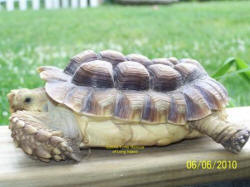 Kept in a glass tank, no substrate, no uvb, poor diet. |
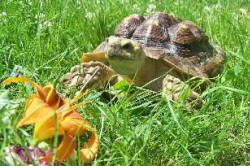 Overall poor husbandry. |
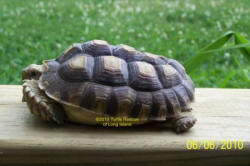 Overall poor husbandry. |
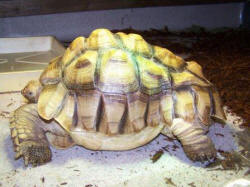 Fed dog food for at least seven years. |
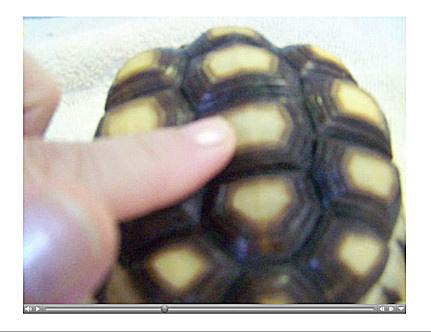 Please don't let this happen to your new Sulcata . (Click here to view movie) This was a very small, young Sulcata that was brought in that was found by the persons grandchildren. Back legs barely moved so suspected impaction but died before we could get it to vet for x-ray. The shell was so soft and pyramided it certainly was not given any good care at all in it's short lived life. Whoever had this tortoise had no right to keep such a magnificent tortoise and neglect it so terribly. It died a slow terrible death. Shame on those that do this to these tortoises. |
|
Those are just a small sample
of the many that have come into our rescue looking awful. It breaks
your heart when you have a tortoise come in that canít even hold itís
own weight on itís legs because itís so weak from poor nutrition and
just overall poor care, all because itís owner didnít take the time or
just didnít care enough to give the tortoise the nutrition and
environment it needed . Donít let your tortoise fall victim to
neglect like these have. Itís so easy to give them the simple care they
need to live a long healthy life. The basics are so easy.
Lots of sunshine (UVB lamp) Temp range 95F - 70 F
Grass and weeds (Hay/greens)
Fresh water (easy access water dish/humidity at substrate level)
Exercise (big enclosure)
We have on our site the
Sulcata Challenge: take a look. If youíre not up to the challenge a
Sulcata is not for you. If you think you can take one and keep it until
itís too big, think again. Zoos are full, rescues are full, sanctuaries
are full and good homes are becoming hard to find. We stopped charging
a fee to take them in because we found people were dumping them but Iím
afraid at the rate we are getting them in we are going to have to
impose that fee once again. We just canít afford to continue to house
and feed the many that come in here. At the time I am writing this
article I have 15 of these magnificent tortoises here and we have
already placed several this year. Sad.
If youíre going to keep a Sulcata let him grow up to be a beautiful Sulcata tortoise. Give him everything he needs and make the lifetime commitment.
A healthy hatchling can grow to be a beautiful adult if given proper care. The above tortoise is an example of what a healthy tortoise should look like. No lumps, no bumps.
Sulcata Challenge: http://turtlerescues.com/
Sulcata Information: http://www.africantortoise.
Hay, Lighting, Etc.: http://www.carolinapetsupply.
Check List:
· No glass tanks, need large open enclosure
· Substrate 50/50 mix coir / play sand or similar kept slightly damp
· 70% grass or hay 30% weeds or greens (High fiber - Low protein)
· Lots of sunshine or good UV/heat lamp
· Temp range 95F (35C) to 70F (21C)
· No fruit except occasion cactus pear
· Creamy urates are normal but if they start getting gritty the tortoise is dehydrated
· Avoid pellet diets - they are made with grains and fillers, not good food**
* http://www.cites.org/ (Convention on International Trade in Endangered Species)
** http://www.sawellnesscenter.
©2010 Turtle Rescue of Long Island - all rights reserved.
All material herein © '2004-2013 "Long Island Turtle Rescue". All Rights Reserved
